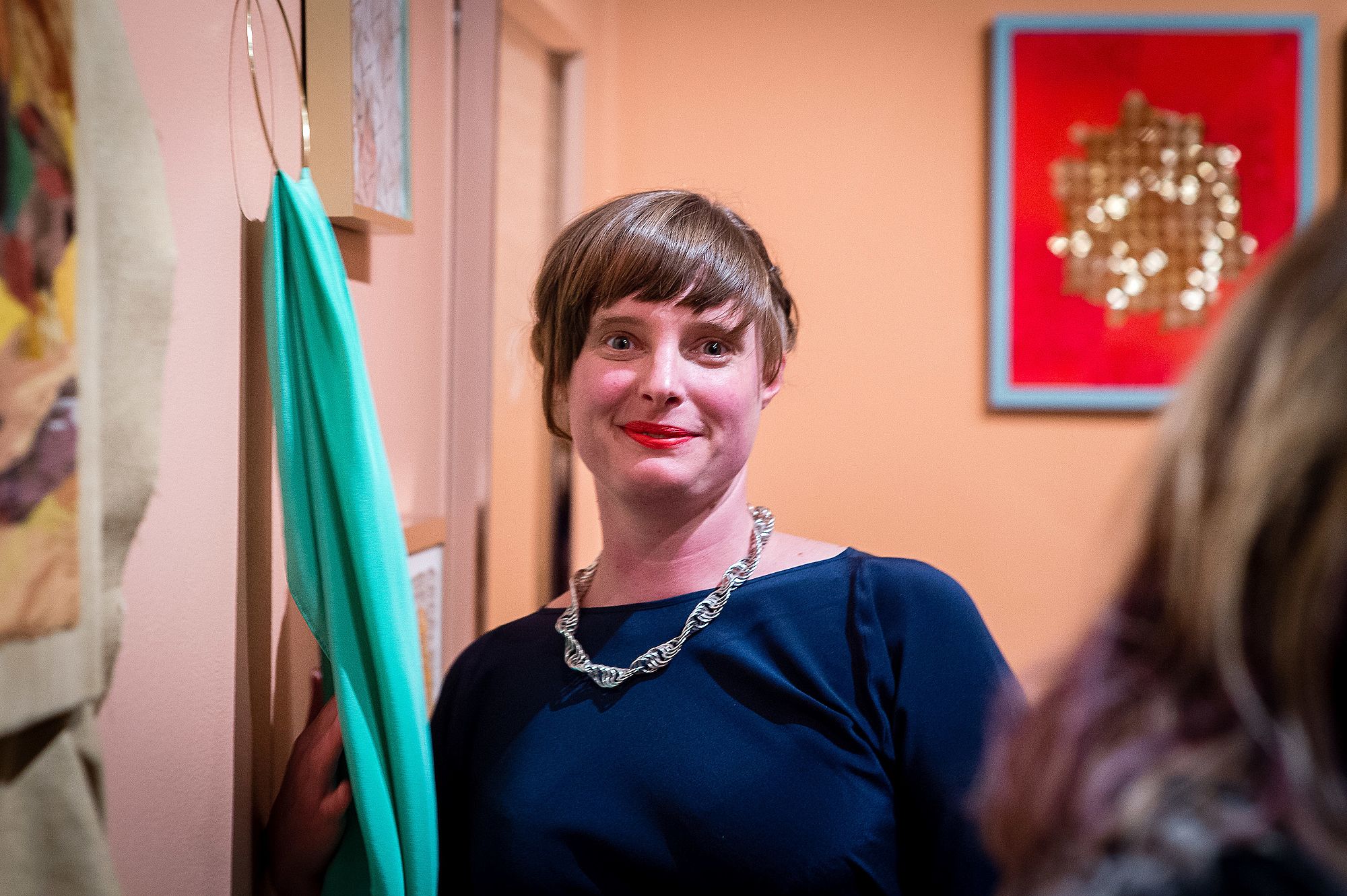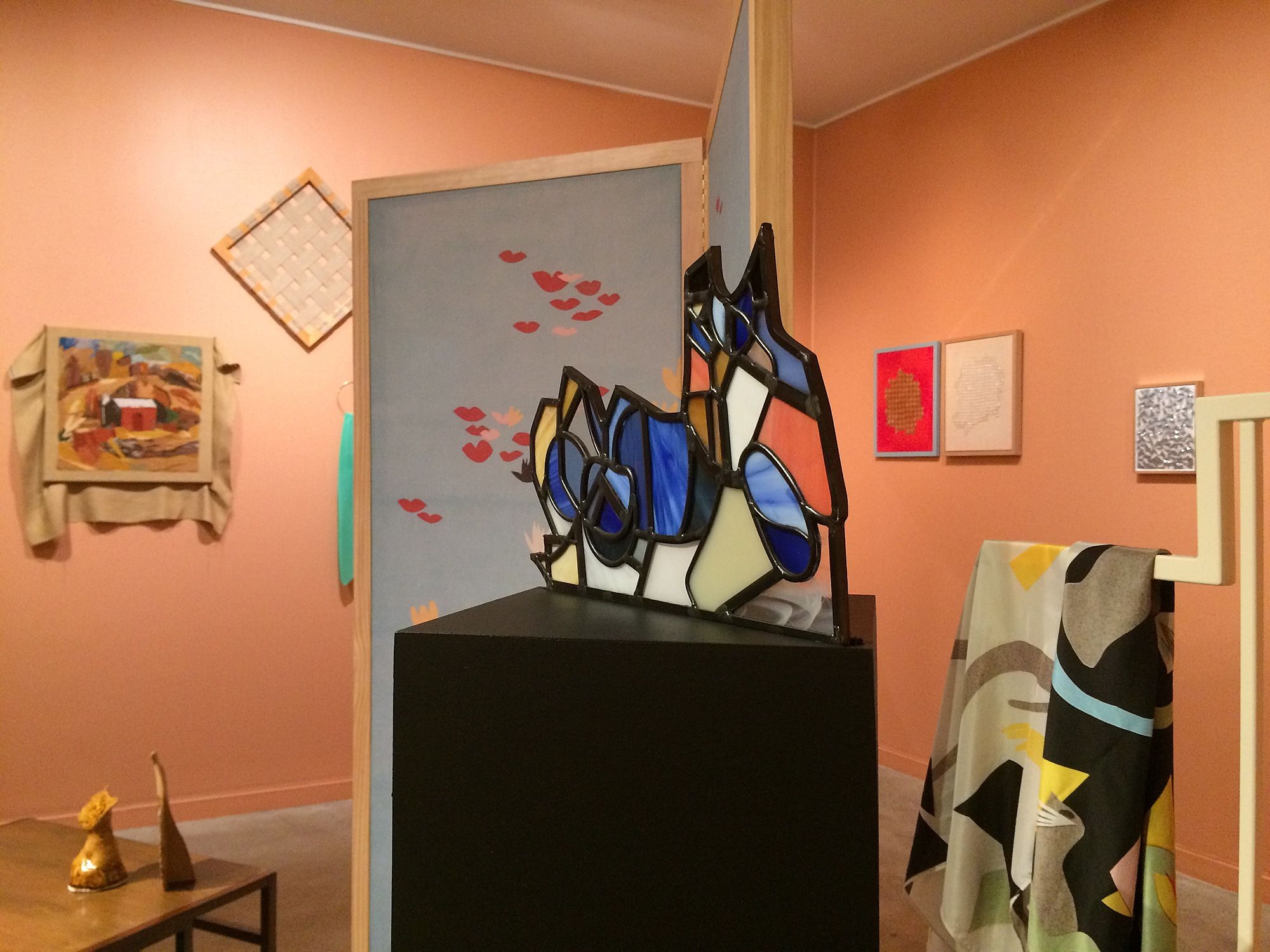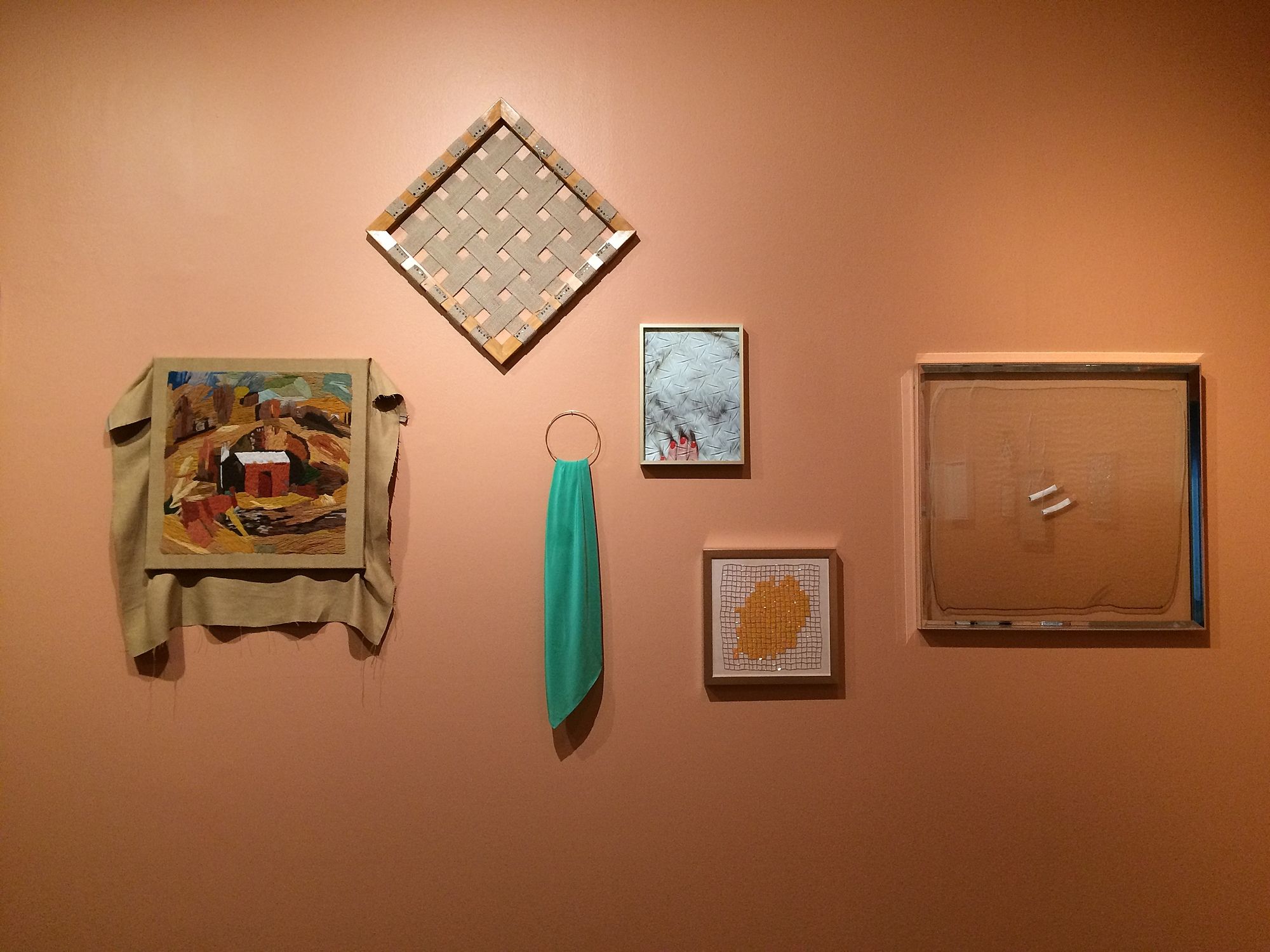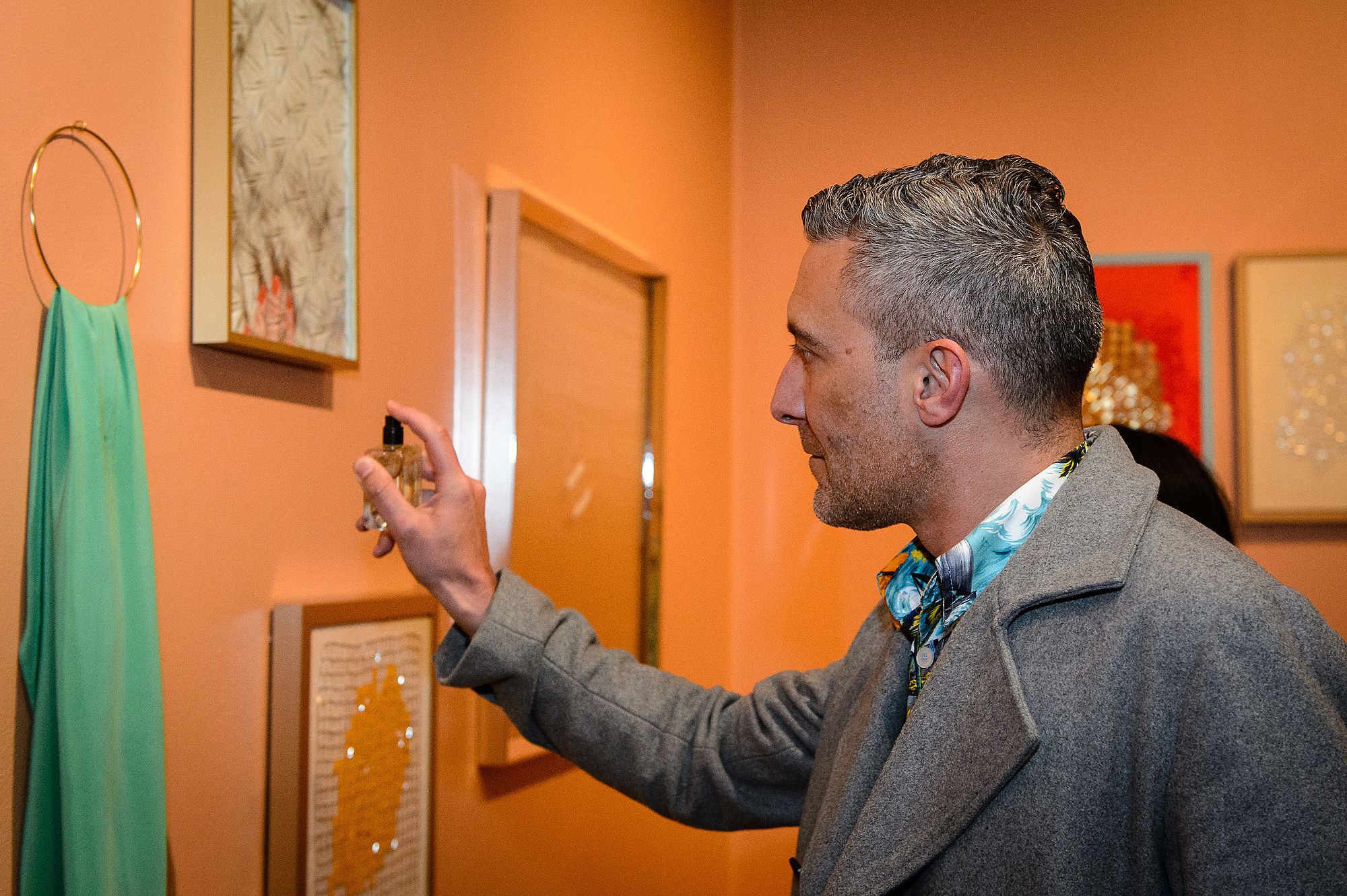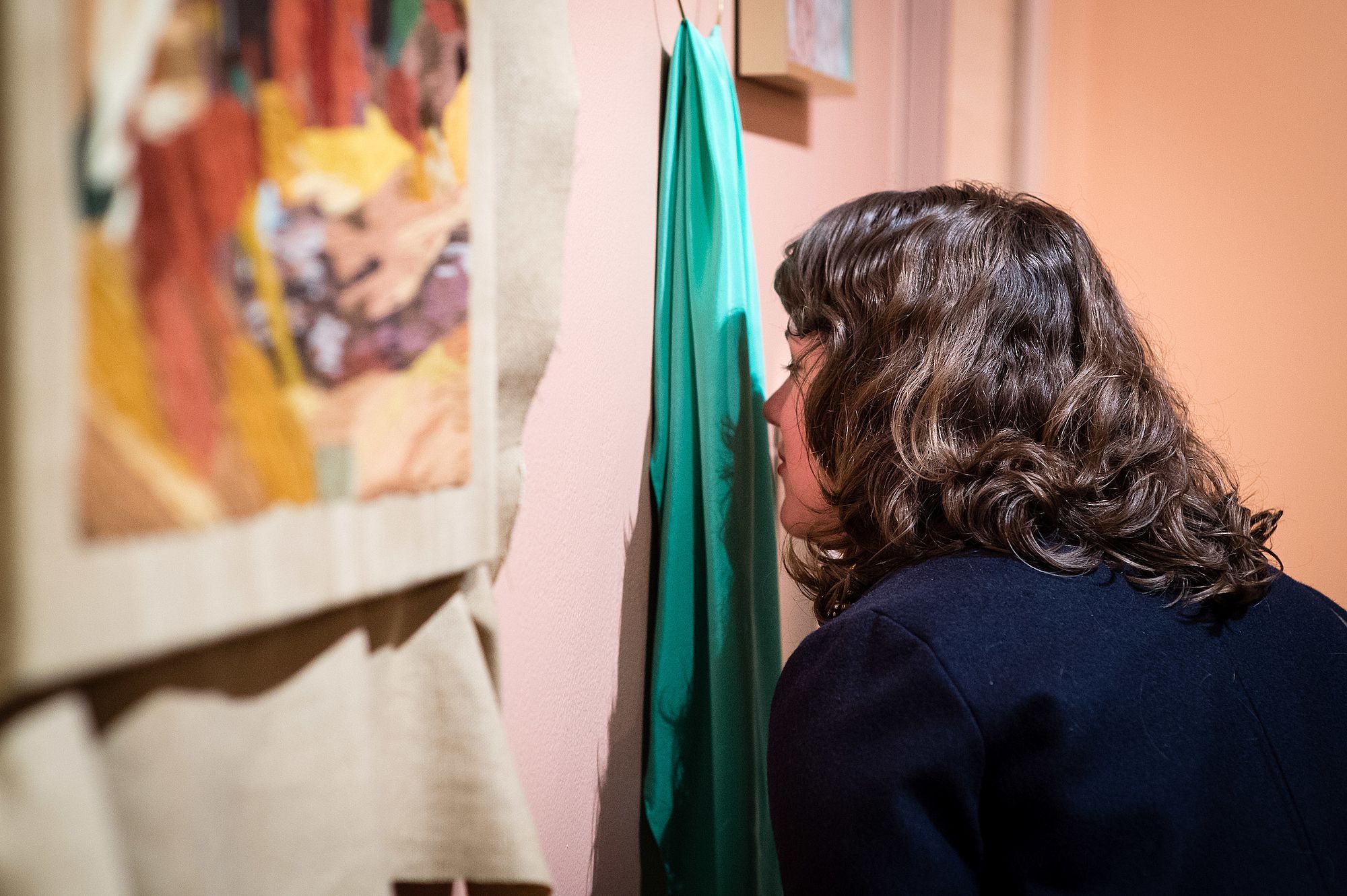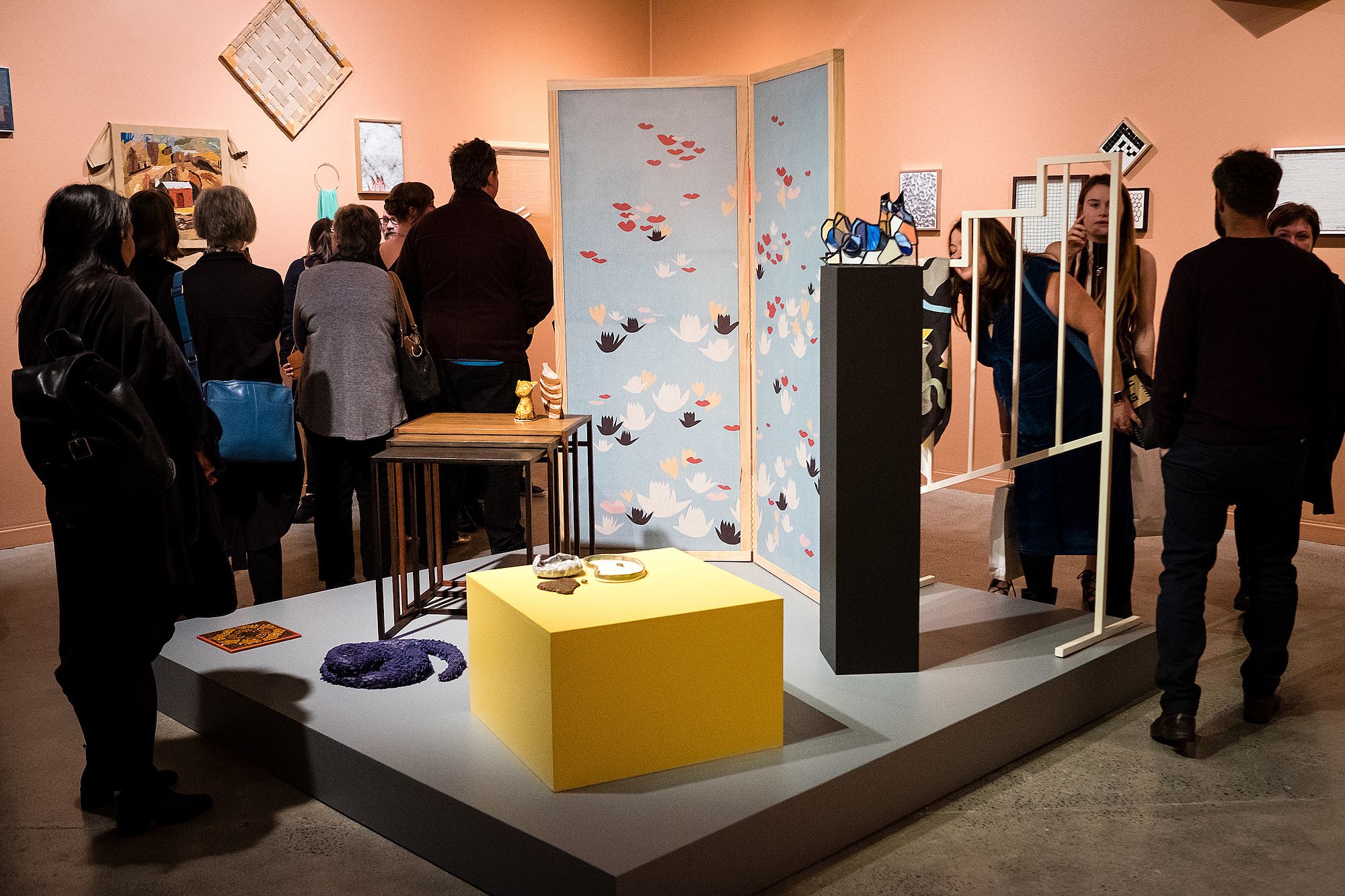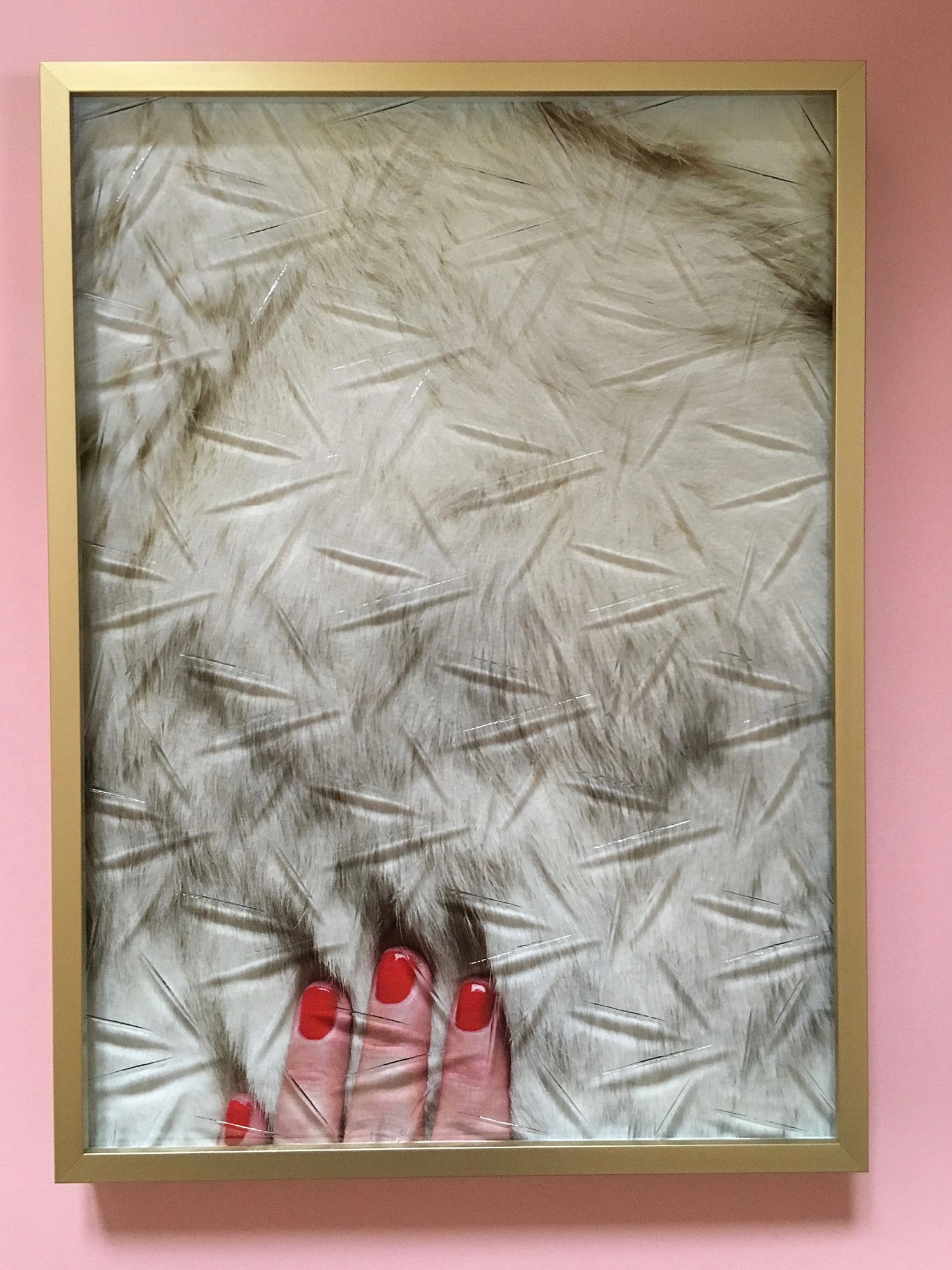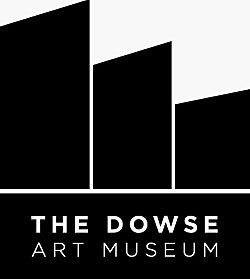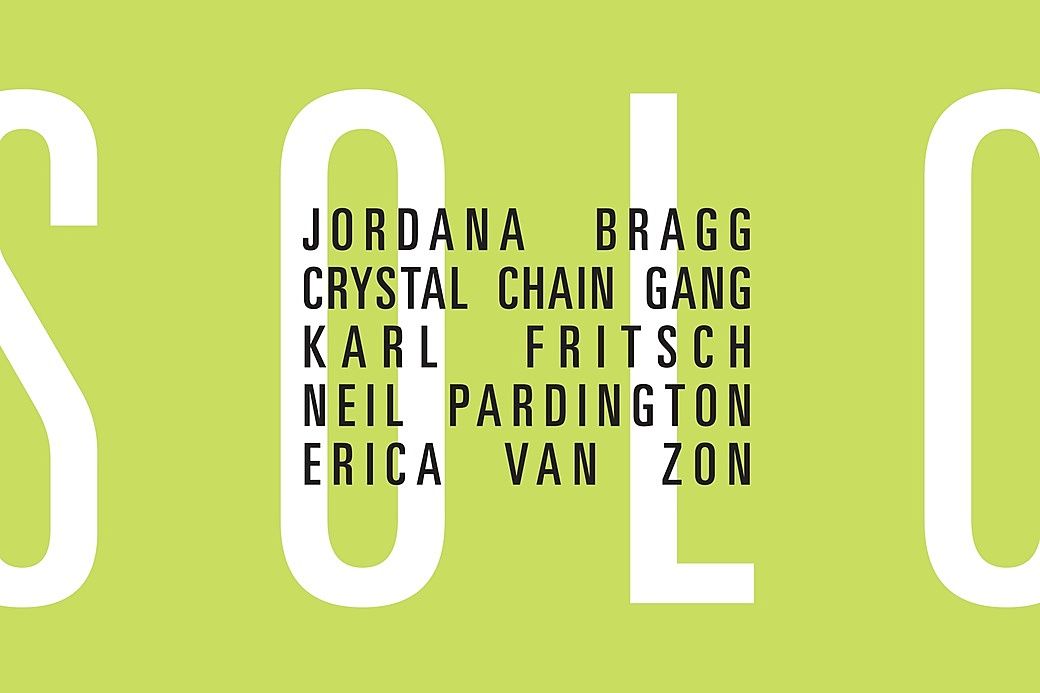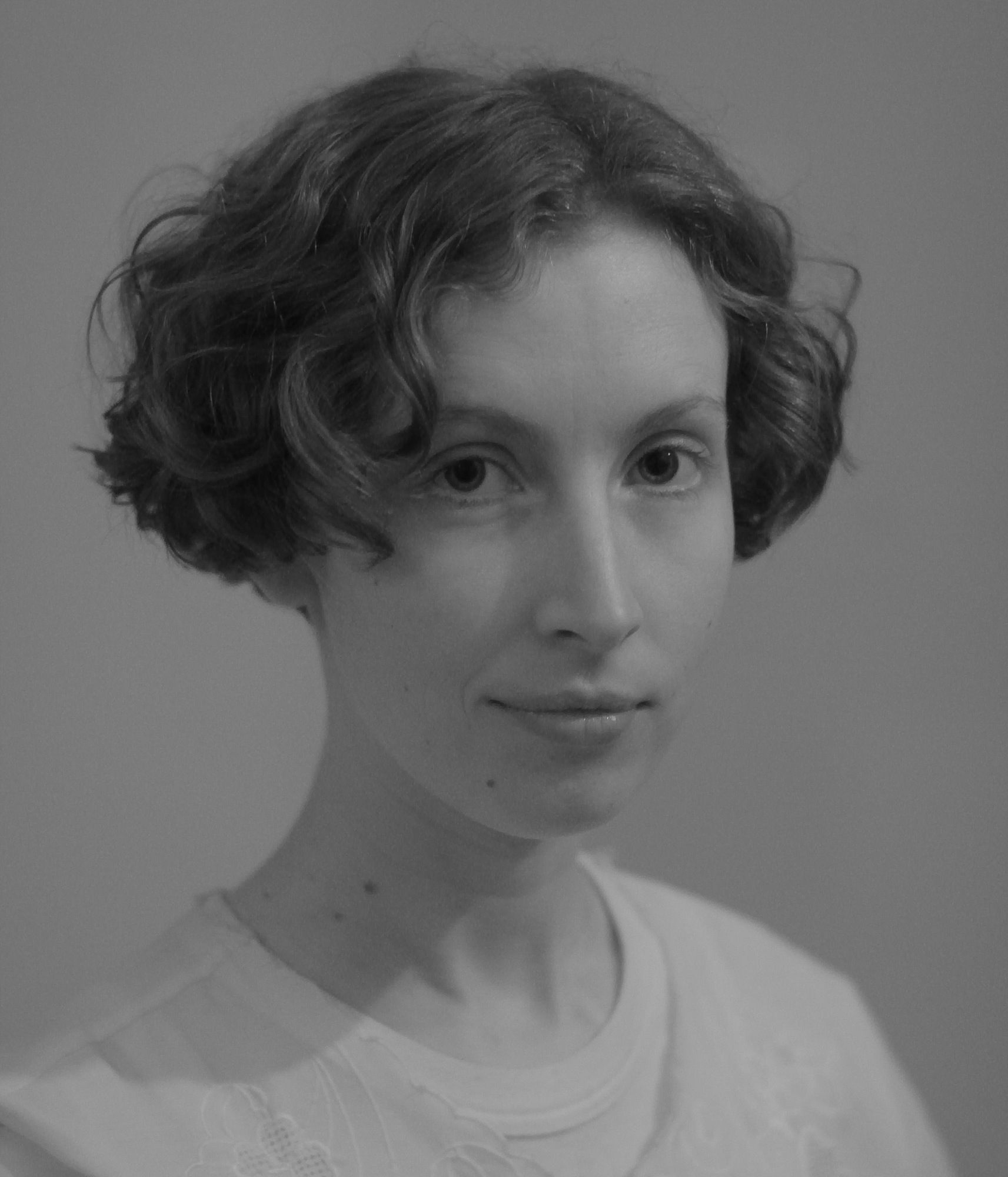Uncanny Valley: Erica van Zon on slippage, scratchy wool and New Zealand's first dealer gallerist
Victoria Wynne-Jones chats to Erica van Zon, whose work is currently at The Dowse Art Museum as part of Solo 2016: Six Wellington Artists.
Victoria Wynne-Jones chats with Erica van Zon, a multi-media artist who finds inspiration in local histories, popular culture and op-shopping.
This interview is presented as part of a partnership with The Dowse Art Museum, where Erica is currently exhibiting a show entitled Coffee Perhaps as part of Solo 2016: Six Wellington Artists.
Erica van Zon’s works have the capacity to induce joy. Whilst gallery-minding one of her recent exhibitions I was struck by the sheer number and variety of people who wandered into the gallery beaming and exclaiming their delight aloud, from tiny toddlers to elegant matrons. They all billed and cooed at the multitude of objects spread out like a banquet on ply. There were tiny individual kernels of popping corn, mandarin peels and cigarettes all lovingly rendered in painted clay. There were textile works in wool, velvet and beads, bizarre re-creations of household chores, assemblages of found sculptural elements and re-creations of familiar architectural landmarks. There was even a ceramic grapefruit hedgehog, the orange fruit cut in half, complete with dimples and studded with toothpicks holding cubes of cheese and cherry tomatoes.
The only constant throughout van Zon’s practice is her intimate embodiment or re-visitation of pre-existing artistic forms and gestures. Something of a moving target, in the past she has given glamourous and camp performances, constructed film-sets from cardboard, re-painted old movie posters, crocheted rugs and stitched tapestries. One particularly savvy manoeuvre was Moving Forward, an exhibition at Rm gallery of van Zon’s personal archive, an impressive accumulation of material, thoughts, notebooks, journals and artworks from the years 1996 –2012. It made me think of the way artists internally wince when they are referred to as ‘emerging.’ Moving Forward was like a self-organised retrospective, a proud declaration that seemed to say ‘Emerging? I’ve been doing this for sixteen years for Chrissake!!!’
There is no doubt that van Zon is gaining traction. The inaugural recipient of the Iris Fisher postgraduate scholarship at Te Tuhi in Pakuranga, van Zon graduated from Elam in 2008, and has been artist-in-residence in Beijing and Dunedin. Notable exhibitions in and around Wellington include the City Gallery, Pātaka and the Dowse to which she now returns. Van Zon’s work was previously included in two previous curated shows at the Dowse: her ceramics in Slip Cast in 2014 and two hand-hooked rugs in Knitted and Knotted in 2011. Her latest outing, Coffee Perhaps is inspired by Helen Hitchings (1920-2002) a glamourous pioneer who opened the first dealer gallery in New Zealand in 1949 replete with furniture, textiles, ceramics and paintings by the likes of Rita Angus and Colin McCahon.
This interview was conducted by email over the past few weeks. On reflection, it is symptomatic of the majority of dealings I’ve had in the past with Erica: although these have often been by remote, they are always marked by the generosity and support she gives her fellow ‘women in the arts.’ During the exchange I imagine her as I usually see her at exhibition openings: swathed in silk with a brightly-coloured lip.
Victoria Wynne-Jones: I often feel a strange sense of inevitability each time you take up a different medium. It just seems right when I see that you have turned to, for example crochet hook rugs, stained-glass or even silk. Do you encounter a sense of the inevitable when utilising a new medium?
Erica van Zon: Yes, I have this feeling a lot of the time when I'm making art. I'll at first be sort of allergic to materials – for example before I started making rugs I felt allergic to wool in general and didn't like it as a medium. Then I go there. Once I make one thing, I'll spend a few months on it and say ‘never again!’, [but] then I'm addicted, and all ideas manifest with a similar material trajectory. I've already started thinking of the next thing while I'm working on the current one using similar materials. I need more hands. I'll start with rules, like ‘tapestries need to represent an abstract idea such as “looking over the desert at a certain time of day over and over again”—then, in time, it becomes commonplace to use the same materials and process to represent other things like ‘an abstracted street scene in Dunedin.’
Everything I use… the handmade is apparent, even if it's not my hand in the making. Like with the lead light, I can still claim it. I feel influenced by materials; like a magpie, I'll encounter different processes when I visit shops, or look back over craft books, or remember making things as a child.
Sometimes I can see a process or materials coming like a train on the horizon; it will pop up somewhere and I'll lock into it. For example, I've been experimenting with using canvas stretcher bars to represent the back of a chair, now I can see that form as a stand-in for a frame for a 1950s backpack. And then it will become something else... It's sort of old fashioned, working in a series. With the Helen Hitchings (HH) show, I have a few guidelines in place, such as the beaded works representing abstract architectural surfaces. At first it was using glass beads to represent glass. I ended up using longer glass beads to represent Samoan Floor Matting, so twisting the guidelines slightly. Basically for me it's direct, the materials to hand that best represent the original thing from real life.
Sometimes I can see a process or materials coming like a train on the horizon; it will pop up somewhere and I'll lock into it.
I'd get bored using the same process or materials for years, so I try to have a few things on the boil. At the moment I'm making collages and some clay objects; getting a steel piece made; and working on an abstract brick beaded piece. So all up it looks inevitable that I'm going through different processes in series, when you are seeing the work as a group, but it manifests concurrently over a long period of time.
I’m glad you mentioned hands, as well as being a bit of a magpie. That’s something else I associate with your practice, an obsessive kind of re-making as making, as well as the creation of great collections of things!
I guess that I have always been influenced by the world around me – as most artists are. The re-making will start from one place or idea, such as looking at my bookshelf, and work out from there. I try and re-create and re-present the world back to myself and others, creating new relationships and narratives. The reason for such a varied output is that the obsessive making (rugs, tapestries, beaded works) is balanced with the quicker-turn-around items (ceramics, sewn pieces, wooden works.) I'm interested in amassing bodies of work, recognising the objects that make up our world, that strike me as forming a collective narrative, creating recognisable moments and observances.
Specifically, looking at the HH project, which is all about honouring, I am trying to re-create quite a few aspects of HH, her gallery and her life. I've been working on representing the world that we both inhabit, the confluence of art, craft and design on a domestic scale, and honouring women artists within this. HH was a great feminist! This project is a celebration of what Judy Darragh calls ‘Feminine Technology’.
Then there is the gallery space, which was very cutting edge for its time. Helen brought some of the most critical and important artists, designers, musicians and poets of the era together. Something that is really important to me, for every show, is creating an environment where people feel welcome, so that they're not alienated from the art, or made to feel they don't belong in the space. HH was really into guests/customers being able to interact with the work, linger, celebrate and share. The textures and surfaces were refined but homely. The aroma of coffee would enhance the environment. In Dutch culture this is very important – we have a name for it, gezellig – so I totally related to HH's gallery environment through my own cultural perspective.
Then I got to thinking about our shared environment, the Blythswood building. Helen had an apartment upstairs from our place in the 1980s, and my separate studio looks into her place. I have been thinking about the communal areas and the textures and surfaces that we both share. I wonder what it was like to move here after having had quite a bit of control over one’s environment. HH was a theatre designer before she had the gallery and she knew how to control spaces with colour and texture, so having to share spaces and communal aesthetics must have been an interesting part of her life. There is a cheap print of Constable's The Hay Wain in the lobby. What would passing that be like after having celebrated and sold some of the most important art in New Zealand in the 50s? How would she have felt about the 1970s lino?
I have also tried to represent some other aspects of HH's life: [such as] her cat, Mitzi, and when Linda Tyler interviewed her for her thesis on the architect Ernst Plischke. These works have ended up more like a representation of a memory, or imagining a moment.
So all up, everything that embodies the world of HH is bringing forth a few different interpretational approaches into play, and results in a body of quite disparate objects trying to make sense altogether, like her gallery did. Now I've started thinking through taking on the whole space of her gallery and sort of re-making it for the Dowse, so there are elements that are familiar, like in the imagery of her gallery but it's all different, a touch removed or abstracted.
This idea of honouring women through the telling of a tale with the aid of objects and ambience is super-interesting. Do you feel that you are rehabilitating or re-vivifying HH’s story somewhat? This bringing to attention of female historical figures reminds me of the banners of Emma Fitts for example, those she made for Olivia Spencer Bower and Marilyn Waring.
Yes, I think that there is a lot of currency to looking back to the past and honouring what perhaps was overlooked at the time, especially now that there is a strong focus on feminist practice, something that I've always been aware of and worked with.
It's been nice to re-organise the early 1950s for me through the lens of Helen Hitchings. I'm always going to be born in the wrong era, I've always looked to the past, so I'm always rehabilitating something. For me it felt like I had to make it personal, using our communal spaces and re-mixing motifs and patterns that can stretch into a more universal conversation (such as the Greek key motif, using gridded glass and turning Rutu into an abstract textile.) I like how people who might know nothing about the subject matter could find a way in through their own understanding of the world, and the abstract aspects of the works. Isn't that how most people encounter art work anyway?
I'm always going to be born in the wrong era, I've always looked to the past, so I'm always rehabilitating something.
Through my work I have to live it, though the meditative processes of making the works, I feel I can embody the work and its idea, it's a physical act. There was a moment where I was sort of acting out HH stroking her cat for a photograph, and I looked a picture of her hands and they are a bit the same as mine.
I never saw the 2008 HH show at The Museum of Wellington (then City and Sea) though from documentation [I can see] it had some features that were great – such as using a lot of objects sold through her gallery – but also it had some moments that seemed overcooked, like using cut-outs of objects that weren't available, and a soundtrack in the space. Coffee Perhaps is an artistic project, re-making art history and honouring the focus on the intersection between art and craft, as HH did, through making and re-making.
Yes Emma's work is great, and has a broad reach in terms of research. I love what she does with the domestic textiles en masse, up-scaled, you can't not look at them; it sort of forces us to re-consider the people that they are based on through a human-scale form, as if they are present, and their work embodies them.
On the one hand your practice seems to be about very intimate modes of producing individual objects, but on the other you have a very distinctive style of exhibition-making. Your modes of display, or perhaps what could be called exhibition design, are equally memorable.
Ah interesting you say this! I have always struggled with how to put the work into the space, mainly because of the scale I generally work in.
Now when I'm making something, especially with the HH project, I'll be very aware of how it's going to be displayed as I'm making it. I'm also aware of how I want the work to be approached. My work tends to be two-dimensional sculpture which then will have to have a careful exhibition strategy as I ideally don't want people looking at the backs of things.
I'll set some rules, like with the Dunedin Public Art Gallery show – using the dimensions of a full sheet of plywood to inform the scale of the plinth. In that case, there had been a previous show in the same space with deliberately rough exhibition design, a Rugby World Cup all-male show Boys From the Black Stuff. Aaron Kreisler's exhibition design featured unfinished walls and a raw ply plinth – I wanted to re-claim the plywood plinth from that scenario and re-work it as a feminine object.
The exhibition design for HH is loosely based on her gallery – salon hang, clashing printed fabrics, areas for objects, a dividing screen. I'll be bringing the outside in at times. The terracotta pink wall colour is inspired by a kitchen wall in [architect] Don Wilson's 1950s family home in Whanganui. It's really, really hard to get colour matches as most of the documentation I've looked at is black and white. I really want this show to feel like you have been transported back in time.
A friend of mine who went to art school in the 1990s told me the other day that he thought it was a shame the word ‘slippage’ wasn’t around when he was studying. It’s quite an overused term, however I do get a sense of slippage in your works, a slight sense of wonkiness or wrongness between what you make and the object or artwork that inspired it.
Slippage is where the magic happens, and where artistic license comes in, and a place where you can claim something and use your signature. It's an inevitable part of making art; every creative has slippage in their career, at times, or every day, either conceptually or formally. I think slippage can be transformative, where something becomes art. For me, the slippage is my hand in the making. It's limited! And usually when I make something for the first time, it never turns out how I imagined it. It's always chunkier, or needs some finishing, or isn't quite right. Julian Dashper loved quoting Dutch sayings back to me. One that sticks out is: ‘If it's perfect it's ugly.’
Julian Dashper loved quoting Dutch sayings back to me. One that sticks out is: ‘If it's perfect it's ugly.’
Relating to the idea of slippage, I learnt the concept of artistic failure aged 7 in Standard 1, when we made stained glass windows out of pastry and crushed coloured barley sugar lollies. The class spent ages on the designs and when they were baked (by someone else) they were all burnt and oozing. I didn't recognise mine at first, it was so disappointing. It's that strange, human sense of the imperfect that inevitably happens to me and, slowly I've realised, to all creative people.
About Mitzi, HH’s cat. Did she also inspire the wooden cat in Te Papa’s current mini-exhibition on HH? I love the way you created an image of a hand stroking her fur, behind the glass of a cocktail cabinet. It’s almost like a tactile portrait.
They are two different cats – Mitzi was HH's cat, a Persian whose amazing portrait image is in the archive at Te Papa. The wooden cat in the Te Papa exhibition is E. Mervyn Taylor's Marmaduke. There are a few pictures of HH holding Marmaduke himself, I think she was a cat lover.
The work is special because I was thinking of how to honour this aspect of HH. I was thinking about making a portrait of Mitzi based on the photo made from sugar paper, lemon juice and sunlight. It just didn't work and I'm too impatient. Then I was thinking about a more universal experience of owning a cat, and that is, if you're lucky, a lot of lap-time. I wanted to portray this like visually representing a collective memory, that can speak to more than just Mitzi as a singular thing. HH's hands are very apparent to me, a key feature of hers, they are very strong in most of the posed photographs of her in art situations.
Also that bean casserole dish, it reminds me of the strange objects I often see in second-hand stores. Ceramic pieces obviously crafted with great love, for some distant purpose. HH had these made for her?
The bean pot represents a new way of eating, individually-portioned casseroles. HH had designed these and had them made at Timaru Potteries. Her ceramics were very high quality, modern and about convenience, in this case oven-to-table cookery. I have re-imagined these with our more contemporary living in mind, creating an even bigger dish. I love humour in art, so decided to ramp up the bean component and turn these into art objects, bean pots in the shape of beans with beans.
Perhaps it's their lumpiness or un-usability that makes us think ‘op shop’ straight away. There is a sad feeling to the hand-made ceramics at op shops; even if they are bad, there is dedication there, they've been through the kiln twice and that's no mean feat.
There is a sad feeling to the hand-made ceramics at op shops; even if they are bad, there is dedication there, they've been through the kiln twice and that's no mean feat.
Ah, the melancholy of ceramics past. Speaking of such things, you have a bit of a reputation for being a voracious and highly successful op-shopper. How does this feed into your art practice?
It's usually quite separate. I'm quite deliberate with my materials and op-shopping is all about chance! In Coffee Perhaps there are some tapestry materials that I sourced at op shops. There are a few op- shop items feeding into my upcoming Whanganui show at the Sarjeant next year. For example, some 1970s faux patina mirror tiles, which have been turned into a couple of lead lights, and some fabric printed in Ghana, which I'll use for a beaded piece. Op-shopping is more of a hobby for me, something I've been doing since the grunge era in 1994. Once it took me five hours to get to Whanganui from Wellington because of all the stops!
Erica van Zon’s Coffee Perhaps
is at The Dowse Art Museum
as part of Solo 2016
18 Nov 2016 – 2 Apr 2017
This interview is presented as part of a partnership with The Dowse Art Museum, who cover the costs of paying our writers while we retain all editorial control.
Solo is a biennial exhibition presented by The Dowse that showcases and supports local Wellington artists by actively commissioning and presenting new work.
The series aims to present contemporary art work across a range of media and provides a snapshot of contemporary art practice in Wellington right here, right now.
Solo 2016 features the work of six Wellington artists and includes a spectacular cast-glass chandelier by Crystal Chain Gang (Leanne Williams and Jim Dennison); an installation by Karl Fritsch featuring reinterpretations of the traditional ring; photographs revealing scientific collections in museums by Neil Pardington, filmed performances by Jordana Bragg exploring feminism and the media; and a tribute to early Wellington gallerist Helen Hitchings by multi-media artist Erica van Zon.

